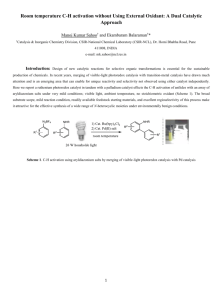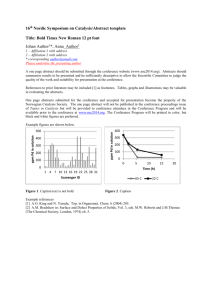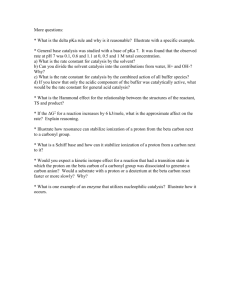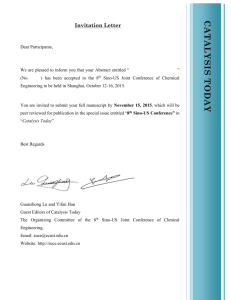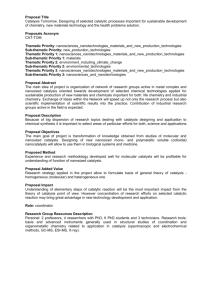Word
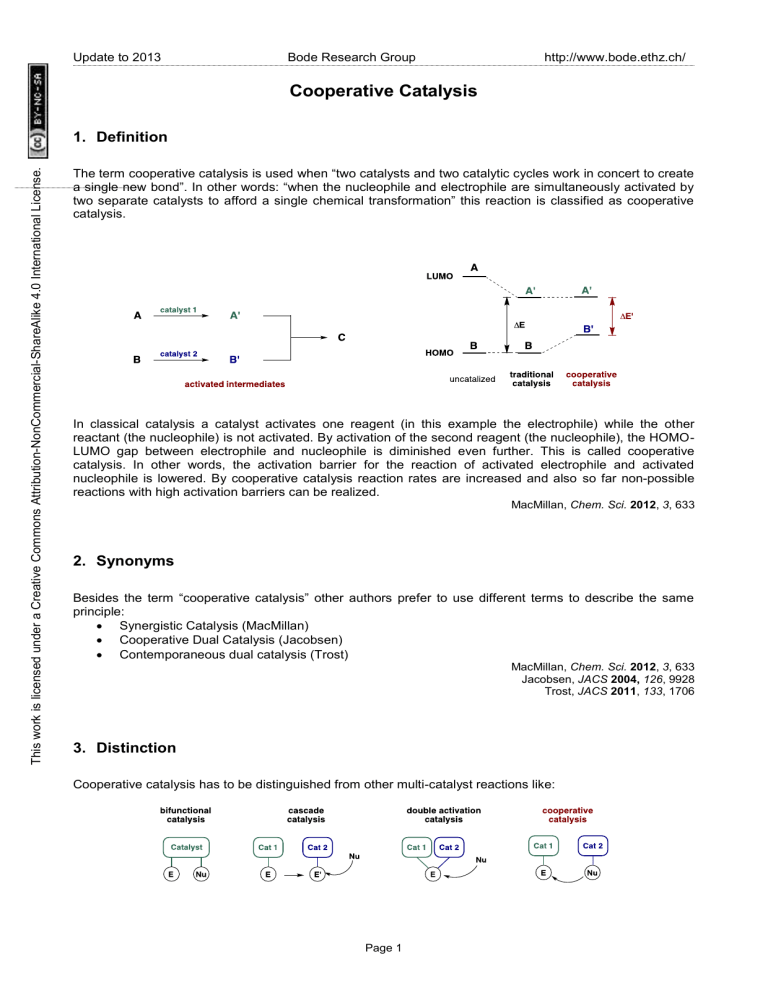
Update to 2013 Bode Research Group
Cooperative Catalysis
http://www.bode.ethz.ch/
1. Definition
The term cooperative catalysis is used when “two catalysts and two catalytic cycles work in concert to create a single new bond”. In other words: “when the nucleophile and electrophile are simultaneously activated by two s eparate catalysts to afford a single chemical transformation” this reaction is classified as cooperative catalysis.
In classical catalysis a catalyst activates one reagent (in this example the electrophile) while the other reactant (the nucleophile) is not activated. By activation of the second reagent (the nucleophile), the HOMO-
LUMO gap between electrophile and nucleophile is diminished even further. This is called cooperative catalysis. In other words, the activation barrier for the reaction of activated electrophile and activated nucleophile is lowered. By cooperative catalysis reaction rates are increased and also so far non-possible reactions with high activation barriers can be realized.
MacMillan, Chem. Sci.
2012 , 3 , 633
2. Synonyms
Besides the term “cooperative catalysis” other authors prefer to use different terms to describe the same principle:
Synergistic Catalysis (MacMillan)
Cooperative Dual Catalysis (Jacobsen)
Contemporaneous dual catalysis (Trost)
MacMillan, Chem. Sci.
2012 , 3 , 633
Jacobsen, JACS 2004, 126 , 9928
Trost, JACS 2011 , 133 , 1706
3. Distinction
Cooperative catalysis has to be distinguished from other multi-catalyst reactions like:
Page 1
Update to 2013
3.1. Bifunctional Catalysis
Bode Research Group http://www.bode.ethz.ch/
The catalyst activates two reactants by separate functional groups, which are located on the same catalyst.
The Corey-Bakshi-Shibata-catalyst is a classic example for a bifunctional catalyst binding and activating both borane (via the Lewis basic nitrogen) and the carbonyl (via the Lewis acidic boron).
Corey, JACS 1987 , 109 , 7925
3.2. Cascade Catalysis
One transformation catalyzed by one catalyst is followed by another independent transformation catalyzed by a different catalyst.
Rovis, JACS 2009 , 131 , 13628
Page 2
Update to 2013 Bode Research Group http://www.bode.ethz.ch/
3.3. Double Activation Catalysis
Two different catalysts activate the same substrate. An example is the simultaneous activation of triple bond by palladium and gold reported by Blum. The following catalytic cycle shows that sometimes it is hard to distinguish between the above-mentioned catalysis modes. Whereas the highlighted key-intermediate is a good example for double activation catalysis, the preactivation of the terminal alkyne by gold facilitating the oxidative activation, could also count as cooperative catalysis.
Blum, JACS 2008 , 130 , 2168
4. Cooperative Catalysis in Nature
Like many other key-concepts of organic synthesis, cooperative catalysis can be found in nature. For example dihydrofolate reductase activates dihydrofolate by protonation of the imine. The second reactant,
NADP + , is catalytically activated to form NADPH, which binds to the enzyme and transfers a hydride to the activated dihydrofolate. Overall, dihydrofolate is reduced to tetrahydrofolate and NADP + is regenerated.
Kraut, Faraday Discuss.
1992 , 93 , 217
MacMillan, Chem. Sci.
2012 , 3 , 633
5. Challenges
5.1. Kinetics
Despite the obvious advantages mentioned above, cooperative catalysis has to overcome an intrinsic kinetic problem. As shown below , A gets activated by Cat1 to form reactive intermediate A’.
Page 3
Update to 2013 Bode Research Group http://www.bode.ethz.ch/
Formulating the equilibrium K
A
shows:
K
A
=
K
____ with
K
A
<< 1
K
A
The equilibrium constant K
A is much smaller than 1 as the activated species A’ inherently has a higher Free
Energy. In other words, the concentration of A’ in the reaction mixture is very low.
The same applies to K
B
:
K
A
=
K
____ with K
A
<< 1 and
K
B
=
K
____ with
K
B
<< 1
K
A
K
B
Combining this information with the rate law for the product formation: d [ C ] dt
= k .
[ A' ] .
[ B' ] shows, that the reactants A’ and B’ are present in very low concentrations, causing a decrease in reaction rate compared to a reaction where only one of the reactants is activated by a catalyst. The increase in reactivity by activating both reactants has to overcome the low concentrations by increasing the reaction constant k significantly. The growing number of important transformations enabled by cooperative catalysis demonstrates the feasibility in many cases. Nevertheless, it is always useful to keep the kinetics in mind when studying this class of catalytic transformations.
5.2. Background reactions
Related to this issue is the un-(cooperatively)-catalyzed background reaction. In enantioselective catalysis the background reaction has a major effect on the enantiomeric excess of the reaction. Ideally, the background reaction does not (or only very slowly) proceed. Otherwise the (racemic) background reaction results in a decrease of enantiomeric excess. Especially in the case of cooperative catalysis, this is an important criteria, since both reactants are independently activated by catalysts and potentially also reactive towards the corresponding unactivated reaction partner leading to a racemic background reaction, if the chiral information is transferred by the other catalyst or only by the combination of both catalysts. The challenge of enantioselective cooperative catalysis is to avoid these background reactions. Having established conditions to avoid background reactions, cooperative catalysis provides access to transformations that have so far not been possible.
5.3. Orthogonality
As two catalysts are used for the reaction, “the catalysts are free to interact with each other. This can potentially result in self-quenching, which renders both catalysts inactive. This can happen through a variety of processes, such as strong complexation of a Lewis acid and a Lewis base or a redox event. The key to overcoming this challenge is the j udicious selection of appropriate catalyst combinations.”
MacMillan, Chem. Sci.
2012 , 3 , 633
Page 4
Update to 2013 Bode Research Group http://www.bode.ethz.ch/
6. An early example for Cooperative Catalysis: The Sonogashira reaction
Arguably, one of the most important cross coupling reactions is the Sonogashira reaction first disclosed in
1975 by Sonogashira, Tohda and Hagihara. Despite, the term “Cooperative Catalysis” had not been introduced yet at that time, the Sonogashira coupling is an instructive example for cooperative catalysis. Two catalytic cycles are working together: Palladium activates the aryl halide by insertion into the Ar-X bond.
Copper facilitates the deprotonation of the sp-bound proton by coordination to the triple bond and forms an organo-copper species that undergoes transmetallation to palladium.
Sonogashira, Tetrahedron Lett.
1975 , 50 , 4467
Page 5
Update to 2013 Bode Research Group http://www.bode.ethz.ch/
7. Allyl additions to CH-acidic compounds by Pd/Rh catalysis
Ito described an enantioselective allyl addition to
-cyano carbonyls. Rhodium forms an activated enolate attacking the π-allylpalladium(II) complex to form allyl-
-cyano-carbonyls (esters, amides and phosphonates) in excellent ee’s and yields. Whereas without palladium no conversion is observed, the expected classic Tsuji-Trost reaction takes place when only the palladium catalyst is used. Interestingly, the reaction rate is significantly lower and no enantioselectivity can be achieved even if chiral Pd-catalysts are used.
The proposed mechanism below explains this behavior. While palladium forms the reactive π-allyl complex, rhodium is coordinated by the nitrile-N to form an activated enolate. This activation results in a higher reaction rate when both catalysts are used. The chiral ligand (AnisTRAP) at rhodium creates a chiral environment around the enolate l eading to an enantiospecific addition of the π-allyl fragment.
Ito, JACS 1996 , 118 , 3309
Page 6
Update to 2013 Bode Research Group http://www.bode.ethz.ch/
8. Allyl-trapping of Meyer-Schuster-rearranged propargyl alcohols
Trost developed a dual catalytic tandem reaction involving a propargyl alcohol that undergoes a Vanadiumcatalyzed Meyer-Schuster-rearrangement followed by subsequent addition of an
Not only does the reaction not proceed without both catalysts being present, in each case when only one catalyst is present, different products are obtained. As shown in the scheme below, if Vanadium alone is used, the classical Meyer-Schuster rearranged propargyl alcohol is the only product and the allyl carbonate can be recovered quantitatively. When palladium alone is used, the expected Tsuji-Trost product (trapping of the
-allyl palladium complex with propargyl alcohol) is obtained in 85 % yield.
When both catalysts are used, the propargyl alcohol undergoes Meyer-Schuster rearrangement but instead of a simple protodemetallation, the allyl fragment is added.
In order to exclude a simple cascade reaction, the products obtained from the single catalysis reactions were subjected to reaction conditions with the other catalyst. But the dual catalysis product was not obtained, demonstrating that both catalysts are needed simultaneously for the desired transformation.
As shown in the mechanism below, the propargyl alcohol undergoes transesterfication with the vanadium catalysts. Subsequent Meyer-Schuster rearrangement gives the vanadium allenoate which in turn gets intercepted by the
-allyl palladium intermediate. In prior work, Trost has demonstrated that this vanadium allenoate can also be intercepted by aldehydes and imines.
Page 7
Update to 2013 Bode Research Group http://www.bode.ethz.ch/
Trost, JACS 2011 , 133 , 1706
9.
-Trifluoromethylation of aldehydes by organo-/Cu catalysis
MacMillan combined an organocatalyst and a Lewis acid in a synergistic way. While copper cleaves the I-O bond to give an electrophilic iodonium intermediate, the aldehyde is converted into a transient enamine being able to attack the iodonium species.
MacMillan, JACS 2010 , 132 , 4986
Page 8
Update to 2013 Bode Research Group http://www.bode.ethz.ch/
10. Alpha alkylation of aldehydes via organo-/photoredox catalysis
An example for the possibility to combine organo- and photoredoxcatalysis is MacMillans
-alkylation of aldehydes. With this dual catalysis mode it is possible for the first time to expand the scope of enamine catalysis towards the use of alkyl halides as electrophiles. This generally results in catalyst deactivation by alkylation if classical enamine catalysis conditions are used. The key aspect of this reaction is the formation of an electron deficient radical, which is intercepted by the electron-rich transient enamine.
11.
Brønsted acid/amine catalyzed
-benzylation of enals
MacMillan, Science 2008 , 322 , 77
If the Brønsted acid and amine base pair is choosen judiciously an inactivation of the catalysts by salt formation can be avoided and catalysis is possible. Melchiorre demonstrated this concept for the
benzylation of enals.
Page 9
Update to 2013 Bode Research Group http://www.bode.ethz.ch/
The acid protonates the dibenzylic alcohol to form a stabilized carbocation with a chiral phosphate counterion. Through a network of non-covalent interactions a highly ordered transition state is formed in which the transiently formed dienamine attacks the carbocation. If the catalysts are mismatched both yields and ee’s drop significantly (< 30 %, < 21 %ee) supporting the simultaneous participation of acid and amine in the transition state.
Melchiorre, ACIE 2010 , 49 , 9685
12. Lewis acid/lewis base catalyzed enantioselective cyanation of carbonyls
Corey developed a dual catalyzed cyanohydrin formation involving the chiral Lewis acid Mg-BOX activating the aldehyde, and the Lewis base BOX forming a chiral cyanide nucleophile. While BOX alone results in racemic cyanohydrin adducts, Mg-BOX alone only achieves moderate selectivity (65 %ee)
It is proposed that TMSCN is hydrolyzed by traces of water to form HCN, which is then activated by BOX to form the chiral cyanide nucleophile.
Even tough BOX alone leads to racemic cyanohydrin adducts, the selectivity drops significantly (38 %ee) if the mismatched opposite enantiomer of BOX is used in combination with Mg-BOX.
Corey, Tetrahedron Lett.
1993 , 34 , 4001
Page 10
Update to 2013 Bode Research Group http://www.bode.ethz.ch/
13. Palladium- and ruthenium-catalyzed direct coupling of aryl halides with pyridine derivatives
Chang developed a Pd/Ru-catalyzed coupling reaction using ruthenium to decarbonylate the pyridine derivative followed by transmetallation to palladium with an insertion of CO into the Pd-OCH
2
-bond. These reaction conditions allow the carbonylative coupling without the need for a CO atmosphere typically used in classical carbonylative crosscouplings.
Following a similar mechanism without decarbonylation, the scope could be expanded to pyridyl formamides and quinolinecarboxaldehydes as substrates for the carbonylative coupling.
Chang, JOC 2003 , 68 , 1607
Page 11
Update to 2013 Bode Research Group
14. Enantio- and Diastereodivergent Dual Catalysis
http://www.bode.ethz.ch/
Recently, Carreira developed an iridium- and organo-catalyzed
-allylation of branched aldehydes. The outstanding feature of this reaction is the complete absolute and relative stereocontrol. By using the opposite enantiomers of the ligand and/or the organocatalyst both enantiomers of both diastereomers are accessible selectively. achiral amine
( R )amine achiral ligand
71 %
0 %ee
3:1 d.r.
69 %
68 %ee / 92 %ee
1.3:1 d.r.
( R )ligand
69 %
99 %ee
3:1 d.r.
77 %
99 %ee
> 20:1 d.r.
When the reaction was carried out with an achiral amine and an achiral ligand, the reaction yields 71 % of a racemic mixture of diastereomers (d.r. 3:1). If a chiral amine is combined with an achiral ligand or vice versa, excellent enantioselectivities (92 to 99 %ee) can be achieved for one diastereomer, but the diastereomeric ratio is low (1:1.3 to 1:3). This shows that both amine and ligand are able to control only one stereocenter each without being able to control the relative configuration. If a chiral amine and a chiral ligand are combined, excellent relative and absolute stereocontrol is obtained.
The well-known effect, that the enantio- or diastereoselectivity is decreased in the case of a mismatched catalyst combination is not observed for this reaction. It has been suggested, that both activated substrates have a planar geometry and therefore in the transition state of the reaction both catalysts are localized at opposite sides thus minimizing unwanted interactions.
Carreira , Science 2013 , 340 , 1065
Page 12
